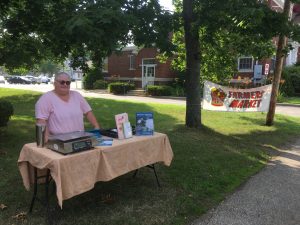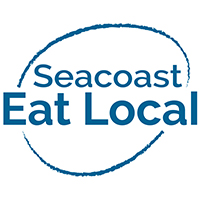Celeste Gingras is the Mobile Market Coordinator for Seacoast Eat Local. She is also a co owner of the wonderful bakery, 45 Market Street Bakery and Cafe, located in Somersworth, New Hampshire. I ride the SAMM van with her every Tuesday, picking up and selling produce at various community and corporate sites throughout the seacoast. This Tuesday I sat down with her to gain some more information on the origin of Seacoast Eat Local and the Mobile Market. Read on to find out more!
How/Why did SEL get started?
Sara- Zoe (a founding board member of our organization) had this idea — she believed that local food should be available to everybody, and she was trying to figure out a way to help the people access this food, and at the same time, help the farmer who’s trying to get the food to the people. Her idea was to organize a non-profit that would bridge the gap between the consumer who needed the food and the farmer who was growing the food. She created a board of individuals with a farming background, together starting some of our earliest programs like Seacoast Harvest and the winter farmers markets. She had talked to farmers who said “Yeah! We can grow food off-season!” She started with two or three farmers markets a year, and then it just started to blossom. She was creating a reason for farmers to grow more and a reason for consumers to get more local food throughout the year.
So- before Seacoast Eat Local was an organization, there were no winter farmers markets?
No, there weren’t any winter farmers markets in New Hampshire that I know of.
And at what point did you get involved?
I want to say it was about 5 or 6 years after Seacoast Eat Local was started that I joined the board. I was on the board for about 7 years then I stepped dow to apply for my current position.
How did you get your current position with Seacoast Eat Local?
Sara Zoe and a bunch of other people had always thought,“Wouldn’t it be amazing if we had a vehicle that we can drive to the people instead of the people having to come to us?” But it seemed like a fairytale. I was on the board at the time and Harvard Pilgrim Healthcare had approached us about their mobile farmers market program because they were seeking a site in New Hampshire. Due to the larger population on the Seacoast and the considerable work of SEL, we were one of a few likely candidates to take on the project. At first, we felt that we did not have the capacity for this program. At the time, we didn’t have any full time employees, we were a volunteer board doing most of the work alongside part time or seasonal staff. I was actually part of the hiring committee who was trying to hire someone who could be the Director of Programs. Myself and two other board members went through dozens of applications and interviews before we came across Jill and hired her. We had also hired Shelly by then, our Program Coordinator.
Hiring two full-time, year-round professional staff was a game changer for us. It kicked off what was a very long process, but which ultimately led to our pursuing the mobile market project. At one point in this process, we were creating the job description for a mobile market coordinator. Writing it, I was thinking “Oh my god, that’d be the best job, that’d be the best of both worlds,” I had been working in farmers markets so long and had great relationships with growers and producers and had a background in social work. I was thinking “This’d be my dream job.”At first, I didn’t say anything to anybody. I didn’t think I could have the job because I’m co-owner of a bakery with Cheryl, and I was working 75 hours a week already.
After doing months of research, Jill selected a bus, had it retrofitted, and delivered right to Jill’s house. In the meantime I had been thinking I really want to apply to this job, so I decided one day to tell Cheryl. I was nervous to tell her because we already had so much going on, I wasn’t sure what her response would be. When I told her she just turned around and said, “It would be crazy for you not to apply.” So I thought, “Ok this is real.” I decided to call Sara Zoe and ask her to meet with me. We went and had coffee one day, and I said, “I don’t really know how to say this to you other than blurting it out but “I really want to be the Mobile Market Coordinator.” and she was like, “Really? Seriously? Well how will that work?” I said that I had Cheryl’s full support and that we would figure it out, we’ll make it work. So she was pretty psyched about it and the rest is kind of history.
What was it like to get the bus into new towns for community stops?
We started the program the first of August and I had to go out to places and tell people what we were trying to do. Not only was it a new program for us but no one had seen anything like it before in New Hampshire. I went to city municipalities and they were like “You’re going to be a food truck?” It was hard to explain what we were, and many towns and cities had no category for what I was about to start. Each town or city has their own policies, and I had to learn how to jump through all those hoops.
What goes into the selection process for these stops?
As an organization, we have identified areas that are considered food deserts or ones that have reduced access to local foods for a variety of reasons. When you are somewhere, you want to be in a smart place so people can either see it or get to it. We try to go to areas that have no access or very low access to fresh local foods. It can sometimes take time to catch on in a new location in the beginning because the word hasn’t reached the people. It’s always great to have community partners to help me spread the word.
Where does the produce for the truck come from?
All of our produce comes from local farms. Some of the farms I use include Riverside Farm in North Berwick, Garen’s Greens in North Berwick, Brandmoore Farm in Rollinsford, Barkers Farm in Stratham, Card Farm in Madbury, Kellie Brook Farm in Greenland, Diamond B Farm in New Durham, Sugar Momma’s Maple Farm and Short Creek Farm in Northwood, and Stout Oak Farm in Brentwood. Just to name a few! Virtually all of the product comes from within 30 miles of a given stop (in rare circumstances it exceeds this, like product sold in Farmington coming from southern Rockingham County). Over the course of a season we are sourcing from 20-35 different farms. Sometimes this means weekly purchases and sometimes it is based on a specific crop, such as when we work with blueberry farms.
How do farmers benefit from this program?
In a lot of ways! It’s a great thing to keep the money in the community. For the farmers and producers who are just starting out, who may not be able to afford to hire another person, it saves them the expense of hiring someone to work at farmers markets, and they don’t have to try to sell it, or waste it.

This program helps make local foods more accessible. It keeps commerce flowing in cities and towns and it can be successful for farmers and producers in the area when they know there is a need/ market to grow products for a program like this. So it benefits the farmer and it benefits the consumer. I also think it’s an innovative program, if we can be doing this, so many other people can be doing it too. I really want people to get to know local food. I think it’s important that everybody has the opportunity to access food. It’s not just people who have more money or more opportunity, I believe that food should be accessible to and by everyone.
If you want to get involved, pick up one of the new editions of Seacoast Harvest, which gives a lot of information about our programs and the farmers that are part of our programs, if you’d like to get involved with the mobile market email [email protected].
